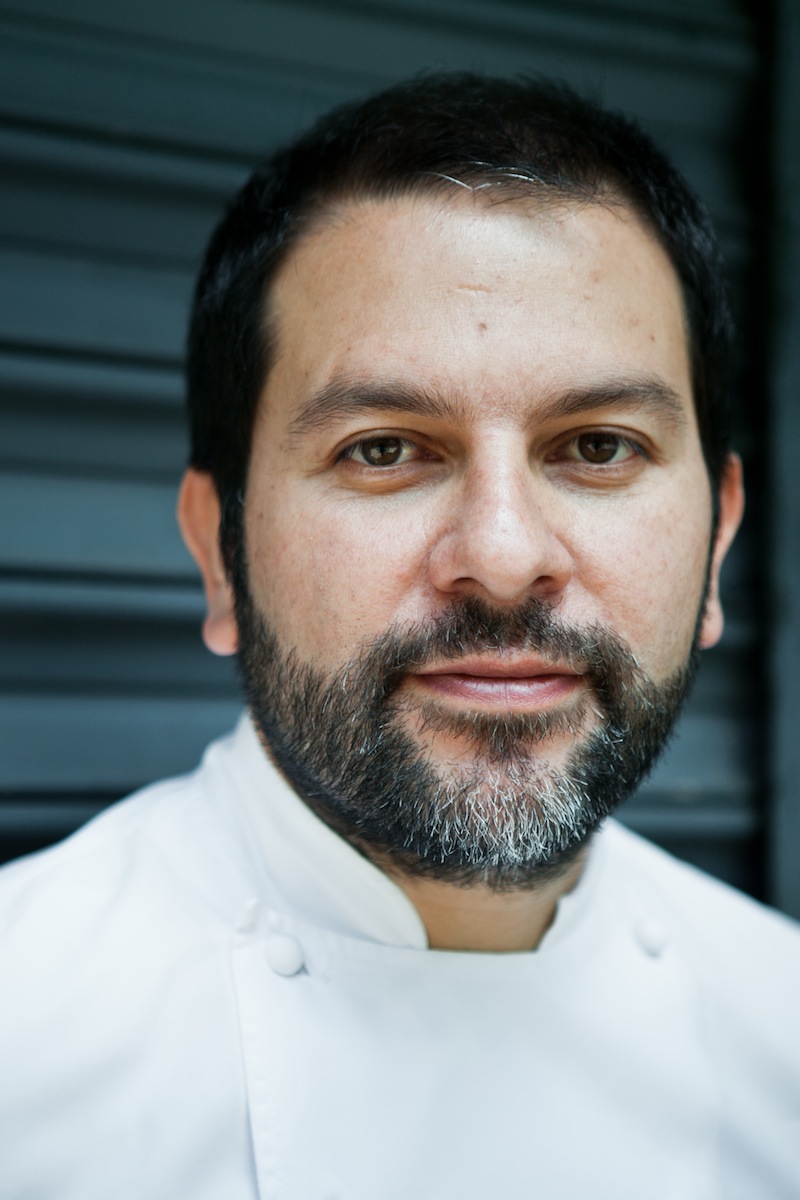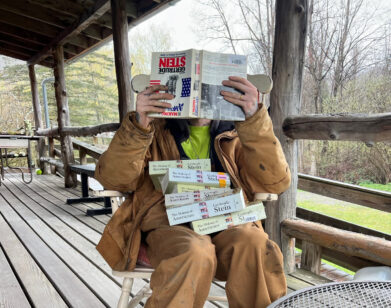Chef Enrique Olvera Goes North of the Border

ABOVE: CHEF ENRIQUE OLVERA
Tomorrow, after several months’ worth of infrastructural delays, Cosme will open its doors in the Flatiron District. During that time, the buzz around the restaurant has heightened to a roar, and with good reason: its chef, Enrique Olvera, is an international star, widely recognized as Mexico’s top culinary figure. His flagship restaurant in Mexico City, Pujol, is regularly included on lists of the best restaurants in the world and was ranked 17th in the world by Restaurant magazine last year.
Olvera is a warm, welcoming presence—exactly the kind of man you want to run your neighborhood joint, which is what he hopes Cosme will become to locals. Its menu will adapt Olvera’s signature style of elevated and reimagined traditional Mexican cuisine to its surroundings: it’s of the utmost importance to Olvera to source his ingredients locally, even if that means introducing some not-quite-Mexican ingredients to a south-of-the-border context. (In fact, that might be what’s got him most excited about the new space.) But it won’t be prohibitively expensive: dishes, including burrata en salsa verde, mushroom barbacoa, and a Mexican-Manhattan clam chowder with cactus and mescal, will run about $15 to $25. And don’t worry: he’s not too good for margaritas.
ALEXANDRIA SYMONDS: Cosme has been described a lot as “hotly anticipated” or “the most buzzed-about new restaurant of the fall,” and you’ve been called things like a new ambassador for Mexican cuisine. Do you think that there is more pressure on you than on the average chef trying to open a restaurant in New York?
ENRIQUE OLVERA: I don’t know. I feel more excited than pressure. Obviously I know the expectations will be higher for the people back home, and we’ll have to deliver. I know we’re not trying to shoot for stars or awards or anything like that. We just want people to like our food and come back. In that sense, Cosme is a little bit more casual than Pujol. Maybe that’s why I don’t feel that much pressure.
SYMONDS: Has the process of preparing to open of a restaurant here been different than opening Pujol or your other restaurants in Mexico?
OLVERA: Yes, definitely. The construction process is completely different. Usually in Mexico it would take us two or three months to do something that size. In New York, it’s taken almost a year. I guess that’s normal. We’re just learning how things work.
SYMONDS: What is it that takes longer?
OLVERA: Obviously in Mexico, labor is much cheaper. In New York, you see maybe five or six guys doing construction, whereas in Mexico you might have 20 or 30 people working at the same time. So that has taken definitely longer. The licenses and the permits with the city have been quite quick; that hasn’t been a problem. It has been more with the construction.
SYMONDS: Do you feel that there’s a club among New York chefs that you’re being initiated into with this restaurant?
OLVERA: I feel like I have a lot of friends in New York, chefs. They’ve been very helpful to me. I’ve talked to Will [Guidara] and Daniel [Humm] several times. They offered their help and they advised me how we should pursue certain things, especially business-wise. Alex Stupak gave me a lot of advice. Everyone has been very nice to us, and we’re very grateful to all the chefs, but I don’t know if we’re initiated yet. I think that will happen after a few months after we open, not before we open.
SYMONDS: How you feel about the way Mexican food gets Americanized here?
OLVERA: Well, I think with any other cuisine—if you think about, for example, Japanese cuisine, you have teriyaki, tempura, and sushi. Usually when the cuisine travels, restaurant tend to simplify and to synthesize the cuisine to one restaurant. The same is true for Mexican food. I think we’re way past the notion of nachos and chimichangas—maybe 20 years ago, that was the case. But now you see great Mexican restaurants in New York and in Chicago and in Los Angeles that are doing something that is Mexican. My impressions on authenticity are a bit different than everyone else’s. I don’t consider myself a traditionalist. I know food, when it travels, needs to adapt. Any cook that has a little common sense should know that the best product is always local. So if you’re not using the local product, that means you’re not a good cook. So I’d rather be a good cook than be an authentic cook. I think that if your soul and your mind is Mexican, even if you’re cooking with things like rutabaga, you’re going to end up with Mexican flavors, because that’s just who you are. You don’t have to try. I don’t have to try to be Mexicanized. [laughs] I’m already there. Even if I cook things I’ve never cooked before, somehow it will end up tasting very Mexican.
SYMONDS: Are there any flavor combinations you’re especially excited to introduce at Cosme?
OLVERA: Yeah, we go to a couple of producers in the Hudson Valley, and we’re very much looking forward to working with them. For example, kohlrabi, we haven’t used that a lot in Mexico—you can find it, but it’s not that common. We’re doing anchovies with kohlrabi and a Caesar dressing—you know, Caesar dressing is from Tijuana—so that salad. We’re also trying to be playful. We’re trying to find local cactus, because we cook here with nopales—maybe with aloe vera or something like that. We’re trying to make a soup with that. We’re exploring different ingredients, and in the beginning we’re opening with a short menu—20 dishes—something more simple. If time goes by and the restaurant gets more solid, we want to start pushing the envelope a little bit more. But I think in the beginning we want to be very consistent and start the conversation easily. I think if I get too crazy, maybe that’s not a good idea.
SYMONDS: How much of the initial menu do you have now? Is it pretty much ready to go, or are you still working on it?
OLVERA: It’s ready; this is the third version of the menu, because we originally thought we were going to open in May. So the idea is kind of the same, but the ingredients have moved a little.
SYMONDS: How often are you anticipating changing it?
OLVERA: It depends a lot on the customers. I don’t cook for myself—when I cook for myself, I cook at home. I want to make people happy, so if people are not happy with a dish, we’ll probably change it right away. And if people really like a dish, then we’re not going to change it, because they’ll probably get upset at me.
SYMONDS: When you were working on the design for the restaurant, how did you want that to reflect your ideas about the menu and the experience of eating there?
OLVERA: We like our food to be very simple, elegant, but with a lot of personality. And that’s what we’re shooting for in the design of the restaurant, with Alonso [de Garay, Cosme’s architect] and Micaela [De Bernardi, its interior designer]. It’s very simple, nothing fancy, but we’ve tried to pay attention to the details. And also, I think that a little bit of character is important, so the floor is cement; it looks like you’re walking into an unfinished restaurant. We wanted to do that so it has that rough character that I think Mexican cuisine also has.
SYMONDS: And that bar is larger than the dining room, right?
OLVERA: Yeah, we want people just to come by after work and have a drink, a michelada or a margarita.
SYMONDS: That sounds good right now. [laughs]
OLVERA: Yeah! I think restaurants must be fun, and I think that’s one of the reasons that fine dining is getting boring, is because it’s too cerebral and ceremonial. We want to do something that people want to go all the time and feel like they can walk in, have a ceviche at the bar, and walk out. We want it to become, also, like a hangout for the locals and have a lot of regulars. I think that the bar will be that place. That’s what we’re shooting for.
COSME OPENS OCTOBER 28 AT 35 E. 21ST STREET, NEW YORK.






